Study reveals how rabbits evolved genetic resistance to myxomatosis through natural selection
Paper published in Science identifies the genetic mutations that evolved independently in both Australia and Europe since the myxomatosis pandemics of the 1950s.
It's been nearly seventy years since myxomatosis destroyed the rabbit populations of Australia, Britain and France, and now an extraordinary study of rabbit DNA spanning 150 years and thousands of miles, has revealed the genetic basis for the animal’s fightback against the deadly myxoma virus.
The new study, published in top academic journal Science, explores the genetic basis of evolutionary change by revealing that resistance to myxomatosis was developed through many small effects spread across the genome, rather than big changes in a few genes. Mutations in the same genes increased in frequency in Britain, France, and Australia, independently suggesting that these genes are central to the evolution of rabbits’ resistance to this deadly virus.
An international team led by the University of Cambridge and CIBIO Institute in Porto collected historical samples from 11 natural history museums in the UK, France, Australia and the United States.
They extracted DNA from nearly 200 rabbits dating from 1865 to 2013, including one owned by Charles Darwin, to establish that modern rabbits in Australia, Britain, and France have developed resistance to myxomatosis through the same genetic changes. After sequencing nearly 20,000 genes to identify mutations that have emerged since the onset of myxomatosis, the study revealed that resistance relies on the collective influence of many mutations of different genes, providing insight into the evolution of disease resistance more broadly.
Museums Victoria contributed six specimens to the study. Some of these specimens may look like little more than roadkill but the genome of DNA they've preserved documents genetic variation in rabbits in the early 1900s prior to the onset of the myxoma virus. The historical genome reference housed in museum collections from Australia to Europe provided a critical window into the evolution of rabbits to resist a virus meant to control their populations.
By harnessing the technology of human medicine, museums are now able to resurrect genome-scale information from a wide range of specimens all across the world. Some date back more than a century and offer a powerful lens into understanding global change in all the species of our planet. Museums Victoria alone houses nearly five million animal specimens, representing more than 30,000 species, collected over almost 200 years. The genomes locked in these specimens have much more to reveal about the evolution of life and the response of species to human impacts on our planet.
Senior Curator of Mammals at Museums Victoria, Dr. Kevin Rowe, said 'this study is just one more example of how the historical depth of museum collections combined with genomic technologies are tackling major questions of real world change. It’s an exciting time for research in museum collections.'
Media enquiries:








